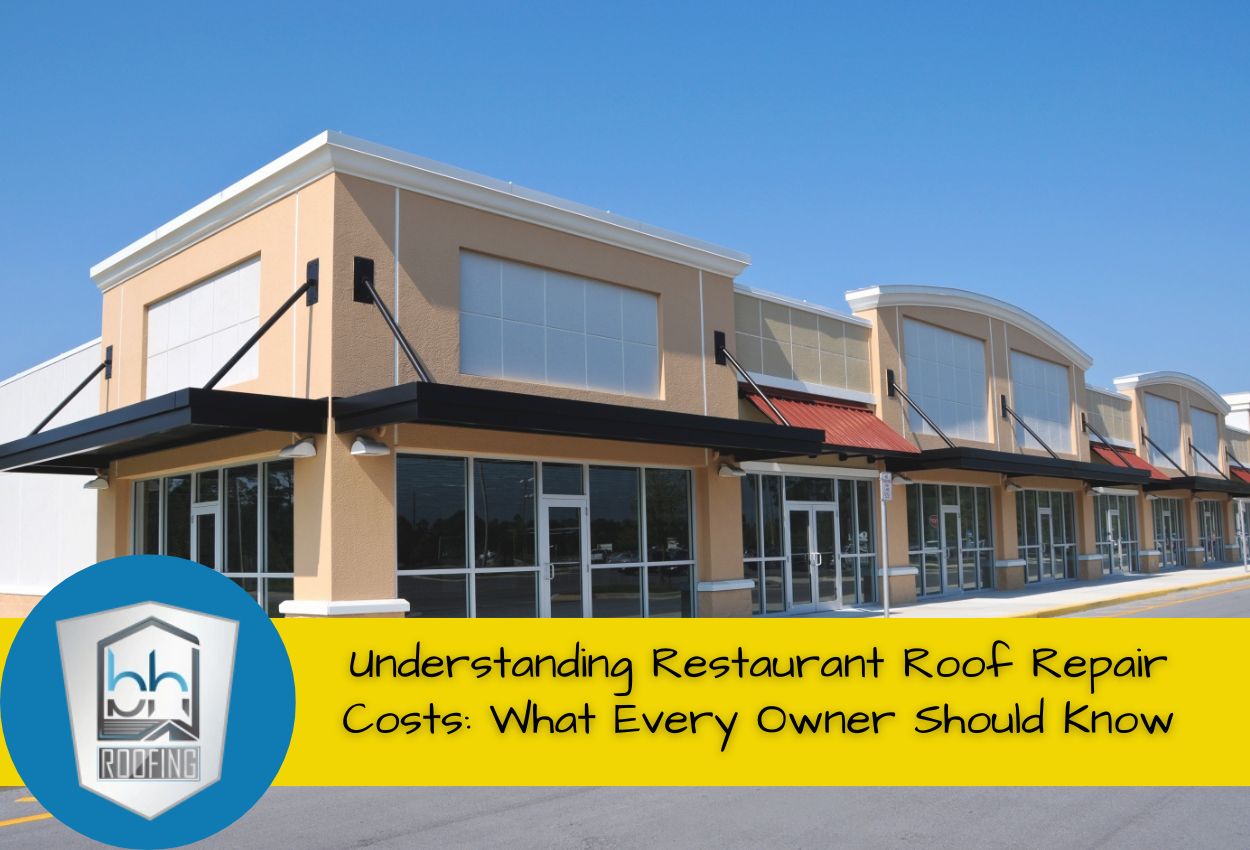Restaurant roof repairs are a critical investment for food establishment owners across San Antonio. Unlike standard commercial buildings, restaurants face unique roofing challenges due to kitchen exhaust systems, higher humidity levels, and grease accumulation that can accelerate roof deterioration. Maintenance isn’t just about protecting the building structure — it’s about safeguarding daily operations and ensuring customers are comfortable regardless of the weather outside.
The cost of restaurant roof repairs depends on several factors, including the size of the roof area, its material, and how severe the damage is. Flat roofs, commonly found on restaurant buildings, require specialized attention to address ponding water issues that can lead to serious structural problems if left unaddressed. Commercial kitchen ventilation systems also create additional stress points on roofing materials that need expert assessment.
San Antonio’s climate, with its intense summer heat and occasional severe storms, creates additional wear patterns on restaurant roofing systems. Professional roof damage inspections for food establishments should account for these regional factors when evaluating repair needs. Restaurant owners who understand the specific requirements of their roofing systems can make better decisions about maintenance schedules and repairs, ultimately protecting both their property and their business.
Common Restaurant Roof Problems That Drive Up Repair Costs
Restaurant roofs face specific challenges that can increase repair costs compared to other businesses. Commercial kitchen ventilation systems create particularly demanding conditions that standard commercial buildings don’t encounter. Exhaust fans continuously expel hot, moist air that condenses on roofing materials, while grease particles accumulate on roof surfaces, breaking down protective coatings and creating sticky residue that traps debris and accelerates deterioration.
The San Antonio climate compounds these issues in specific ways. Our intense summer heat, often exceeding 100 degrees Fahrenheit, causes roofing materials to expand and contract dramatically, creating stress cracks and separations at seams. This thermal cycling is especially damaging to flat roofing systems common in restaurant construction. Additionally, our seasonal storms can drive water into these compromised areas, leading to leaks that may go undetected until significant interior damage occurs.
Restaurants with outdoor dining areas often modify roof structures with partial coverings or HVAC accommodations that create additional vulnerable points. These modifications, while enhancing customer experience, introduce new potential failure points requiring specialized maintenance. Regular professional inspections are essential for restaurant owners to identify any issues with their roof before major repairs are needed.
Flat Roof Repair Considerations for Restaurant Buildings
Flat roofs are extremely common in restaurant construction throughout San Antonio, but they have specific repair challenges that owners must understand. These roofing systems require more attention throughout the year due to their minimal slope and vulnerability to water accumulation. When examining flat roof repair for restaurants, the roofing material plays a crucial role in performance over time.
EPDM (rubber) roofing membranes offer excellent durability but can be susceptible to punctures from kitchen equipment installation or maintenance. TPO membranes provide better resistance to grease and oil exposure from kitchen exhaust systems but may require more attention at seams and penetrations. Modified bitumen systems, while offering excellent waterproofing capabilities, need regular maintenance to prevent UV deterioration in our intense Texas sun.
Drainage is essential for flat restaurant roofs. Internal drains must remain clear of food particles and grease that can cause clogging unique to restaurant environments. Scuppers require strategic placement to effectively channel water away from the structure. Many restaurant owners don’t realize that even small areas of ponding water can lead to premature material failure, especially around HVAC units serving kitchen areas. Professional assessment of drainage patterns should be part of any comprehensive roof maintenance program for food establishments, as proper water management significantly extends roof lifespan and reduces long-term repair needs.
The Hidden Expenses Behind Restaurant Roof Repairs
When planning restaurant roof repairs in San Antonio, owners must consider costs that extend far beyond materials and labor. Business disruption represents one of the most significant hidden expenses. Repairs during peak dining hours can dramatically impact revenue, making strategic scheduling essential. Many restaurant owners find early morning repairs or selecting slower business days minimize customer disruption while protecting crucial service periods.
Kitchen operations also increase the complexity of roofing work. Even minor roof work above food preparation areas requires special containment measures to prevent debris contamination. Health department regulations mandate that restaurants maintain specific air quality and cleanliness standards during repairs, often necessitating temporary kitchen modifications or partial shutdowns that standard commercial buildings don’t face.
Code compliance requirements add substantial costs to restaurant roof projects. Exhaust systems, grease traps, and ventilation components must meet strict safety standards, and any roofing work affecting these systems triggers mandatory inspections. Many restaurant owners are surprised when simple leak repairs evolve into comprehensive system upgrades to satisfy current building codes.
Restaurants with flat roofs face particular challenges when planning repairs around kitchen ventilation systems. These critical components cannot be compromised during maintenance, often requiring specialized work procedures that extend project timelines. Professional roofing contractors with specific restaurant experience understand these considerations and can develop repair strategies that protect both your building and your business operations.
Budget-Friendly Preventive Maintenance to Avoid Major Repairs
Preventive maintenance is one of the smartest investments restaurant owners can make to avoid expensive emergency roof repairs. For restaurants in San Antonio, where summer heat stresses roofing materials and seasonal storms test system integrity, regular inspections should occur at least twice a year. Focus on areas surrounding kitchen exhaust systems, where grease accumulation can deteriorate roofing materials and create fire hazards if not properly maintained.
Restaurant staff can contribute significantly to roof longevity through simple routine practices. Establish monthly cleaning protocols for roof drains and gutters to prevent blockages from food particles and grease buildup that can lead to water pooling. After severe weather events, conduct visual inspections from inside the restaurant, looking for water stains or discoloration that might indicate developing leaks before they cause significant damage.
HVAC units serving kitchen areas deserve special attention, as condensation issues and vibration can compromise roofing integrity around these installations. Schedule professional inspections of all roof penetrations, particularly those associated with kitchen ventilation. For flat roofs common to restaurants, inspect the membrane surface for blisters, tears, or separating seams every spring before the intense summer heat arrives. These simple preventive measures can extend your restaurant roof’s service life by years while avoiding emergency repairs that disrupt business operations.
Choosing the Right Roofing Contractor for Your Restaurant
Finding a qualified roofing contractor for your restaurant requires more research than standard commercial properties. Look for contractors who specifically highlight experience with kitchen exhaust systems, grease management solutions, and health department compliance in their portfolio. Contractors should also demonstrate an understanding of how our local climate affects roofing materials used in food service environments.
Double-check that potential contractors have valid licenses, insurance coverage, and certifications for commercial roofing. Ask for references from other restaurant clients, particularly those with similar roofing systems to yours. Experienced contractors will understand the importance of scheduling work during off-hours to minimize business disruption and have protocols to protect food preparation areas during repairs.
When evaluating proposals, look beyond the bottom line. Quality contractors will provide detailed breakdowns showing ventilation accommodation, drainage solutions, and material selections specifically suited for restaurant conditions. Warranty terms should address thermal cycling, grease exposure, and other restaurant-specific concerns. The best warranties for restaurant roofing projects cover both materials and workmanship for a minimum of 5 to 10 years, with special provisions for areas around kitchen exhaust systems where problems most commonly develop.
Restaurant owners should request information about the contractor’s emergency response capabilities for leaking restaurant roofs, as water intrusion in food service areas can quickly escalate into health department concerns.
Financing Options for Major Restaurant Roof Repairs
When facing substantial roof repairs, restaurant owners in San Antonio have several financing avenues to explore. Commercial property improvement loans specifically designed for restaurants often offer favorable terms, recognizing the unique needs of food service establishments. These loans typically feature longer repayment periods than standard business loans, allowing owners to manage cash flow while addressing critical roof issues. Local banks familiar with the Texas restaurant industry frequently provide customized financing packages that account for seasonal business fluctuations.
Texas restaurant owners should also investigate tax incentives that can significantly offset repair costs. The Section 179 deduction allows for immediate expensing of qualified improvement property, including roof repairs that improve energy efficiency. Additionally, roof upgrades that incorporate energy-efficient materials may qualify for specific tax credits that reduce your overall tax liability rather than just providing a deduction.
When calculating the true cost of roof repairs, consider the long-term return on investment. Premium roofing materials with enhanced UV resistance perform exceptionally well in San Antonio’s climate and typically deliver longer lifespans than budget alternatives. Energy-efficient roofing systems can reduce HVAC costs, creating monthly savings that accumulate significantly over time. Many restaurant owners find that financing quality repairs ultimately proves more economical than selecting budget options that require more frequent replacement and risk business disruption during peak revenue periods.
San Antonio’s Top Choice for Restaurant Roof Repairs: BH Roofing
Understanding the complexities of restaurant roof repair costs is crucial for maintaining your business in San Antonio. At BH Roofing, we specialize in addressing the unique challenges that restaurant roofs face, from dealing with grease buildup and moisture issues to ensuring compliance with health department requirements.
If you’re facing issues with your restaurant’s roof, don’t wait for the problem to worsen. Contact BH Roofing today at (210) 267-9029 to discuss your repair needs and to schedule a comprehensive roof inspection. We offer tailored solutions that fit your budget and minimize operational disruptions, ensuring your restaurant continues to run smoothly.


